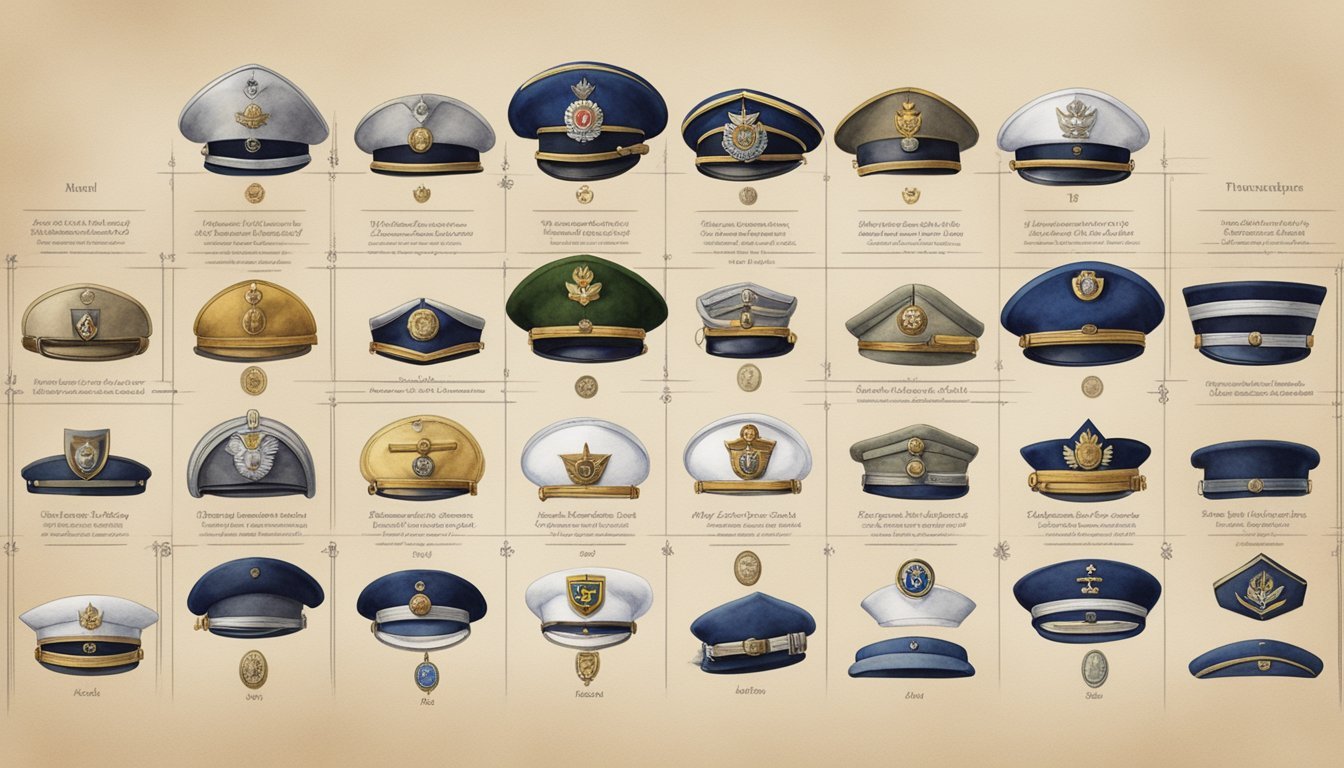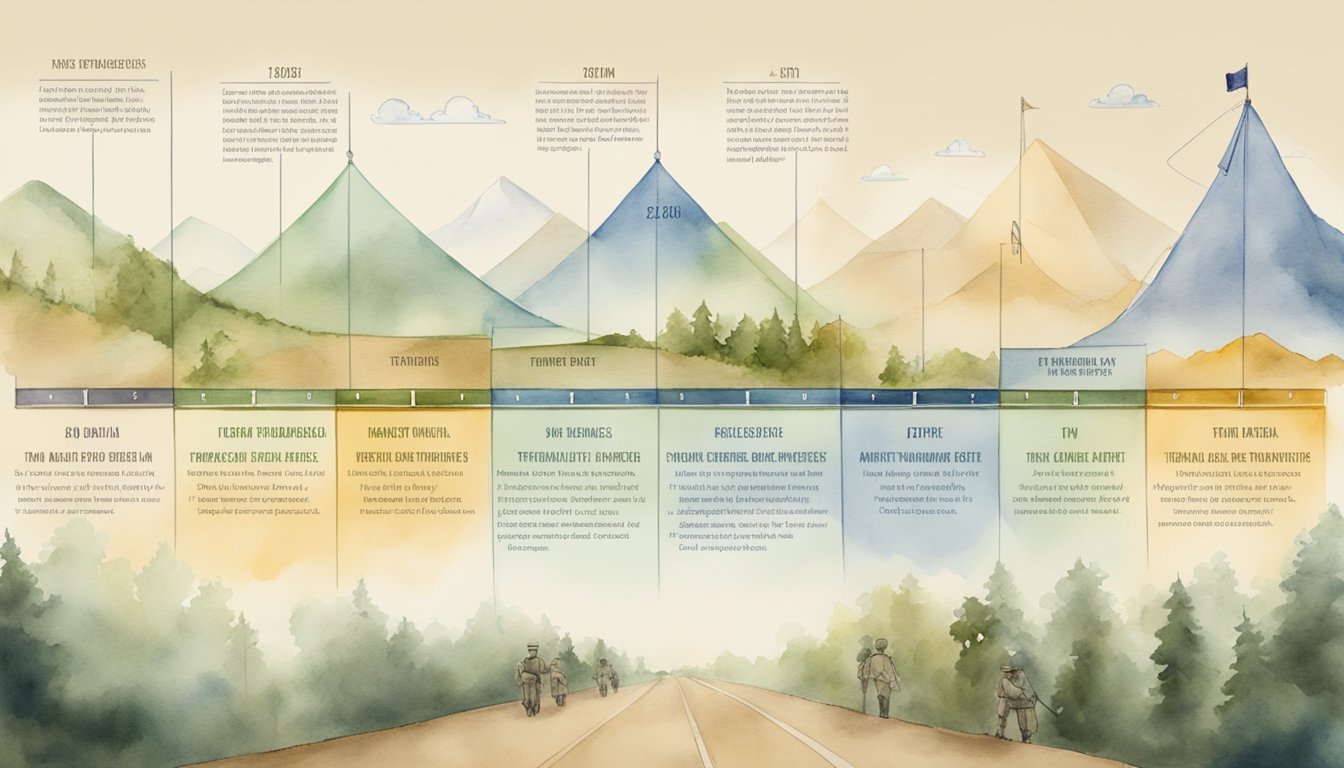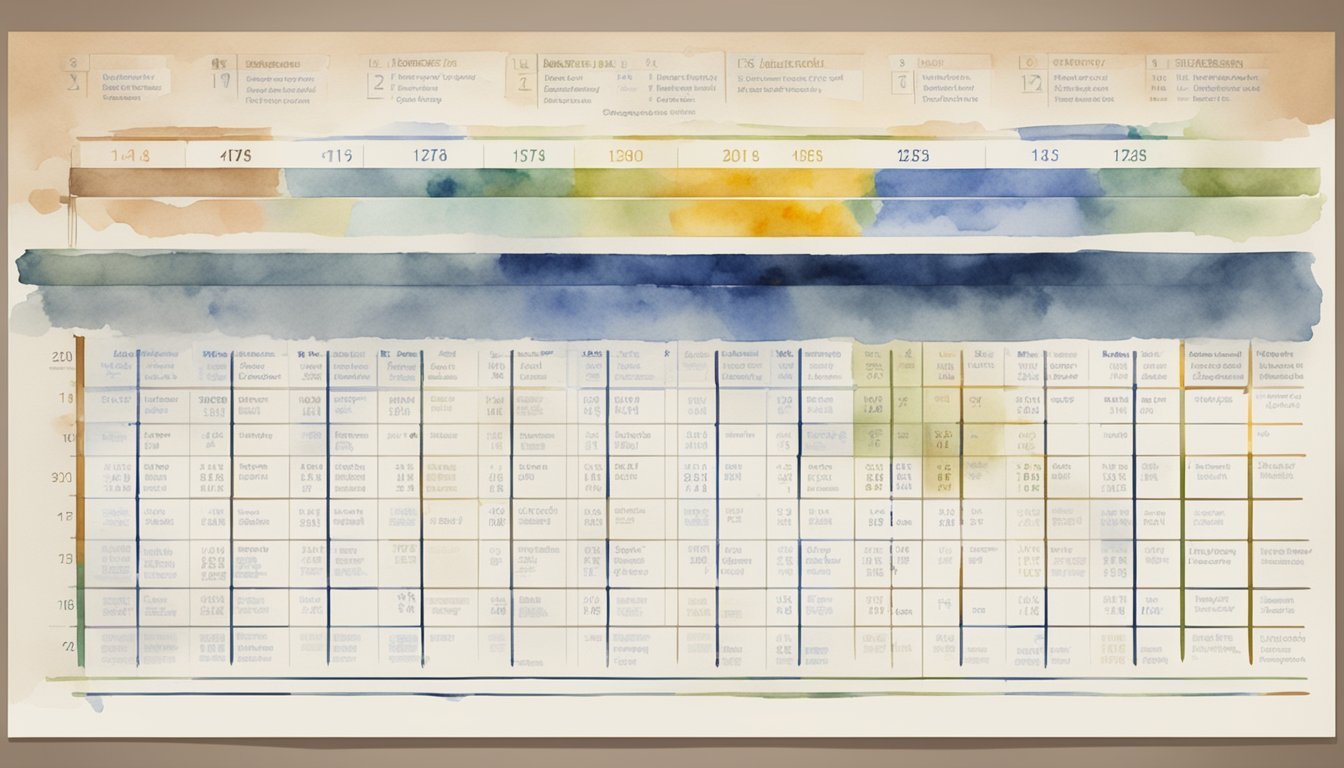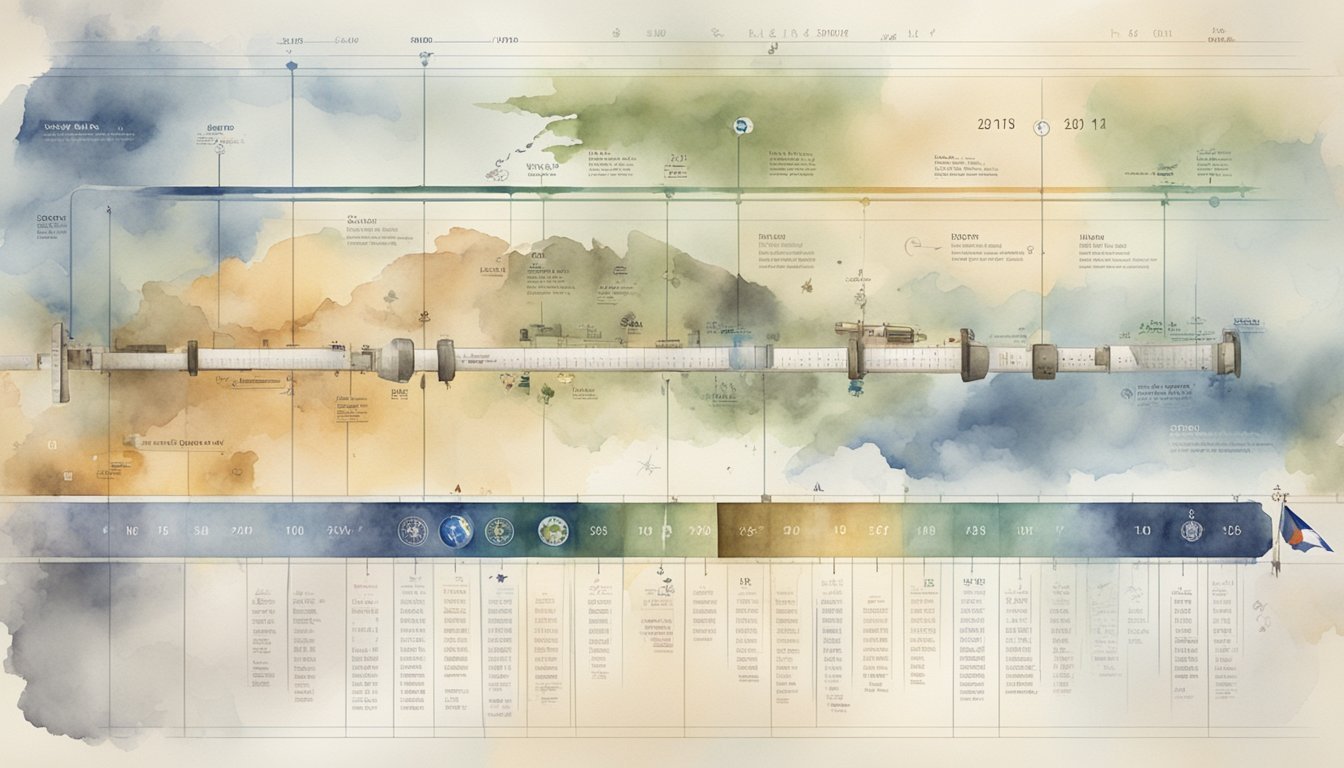Army Promotion Timeline for Enlisted Officers: Tips for Speeding Up Your Career

Advancing your career in the Army requires a solid understanding of the promotion process. The Army promotion timeline for enlisted officers determines how quickly you can climb the ranks. It’s crucial to know the stages, from Junior Enlisted to Noncommissioned Officers, and what it takes to move forward.
This knowledge helps you plan your career path and meet each promotion’s required standards.

The Army’s enlisted ranks consist of various levels, each with its own criteria for advancement.
Promotions are not automatic; you need to meet time-in-service and time-in-grade requirements, complete necessary training, and sometimes go through a promotion board.
Understanding this system can better prepare you for what’s coming next in your military journey.
Promotion boards play a significant role in evaluating your performance and potential.
They look at your scores, training, and service record to decide if you are ready for the next level.
Keep focused on meeting and exceeding these requirements to ensure smooth advancement.
Key Takeaways
- The Army promotion timeline is essential for career planning.
- Meeting time and training requirements is crucial for advancement.
- Promotion boards evaluate your readiness for higher ranks.
Understanding Enlisted Ranks and Promotion Basics
In the Army, enlisted ranks range from entry-level positions to senior leadership roles.
Promotions are influenced by factors like time in service and time in grade.
Understanding these ranks and requirements helps you know what to expect in your career progression.
Enlisted Ranks: From Private to Sergeant Major
The Army has 13 enlisted ranks.
You start as a Private (E-1) and can advance to ranks such as Private 2 (PV2, E-2), Private First Class (PFC, E-3), and Corporal (E-4).
These early ranks focus on building your skills and experience through training.
Senior ranks include Sergeant (E-5), Staff Sergeant (E-6), and more advanced positions like Sergeant First Class (E-7), Master Sergeant (E-8), and Sergeant Major (E-9).
Each rank requires greater leadership and responsibility.
As you move up, you take on more duties and need to complete higher levels of training.
What ‘Time in Grade’ (TIG) and ‘Time in Service’ (TIS) Mean for Promotion
Two key factors for promotion in the Army are Time in Grade (TIG) and Time in Service (TIS).
TIG refers to the amount of time you have spent in your current rank.
TIS is the total time you have served in the Army.
Both are crucial for your promotion eligibility.
For example, to be promoted from E-2 to E-3 (PV2 to PFC), you need a minimum TIG of 4 months and a TIS of one year.
As ranks get higher, these time requirements increase.
This system ensures that promotions are based on experience and readiness.
Understanding TIG and TIS helps you prepare for each step in your military career.
It’s important to meet these benchmarks to move forward and take on new roles.
Breaking Down the Enlisted Promotion Timeline
Understanding how you advance through the ranks is crucial.
Each stage in the promotion timeline has specific criteria, training, and responsibilities.
This guide will help you navigate the path from initial enlistment to senior noncommissioned officer status.
Initial Enlistment and Advancing from E-1 to E-4
When you first join the Army, you start at the rank of Private (E-1).
Basic training is key in this phase, where you learn essential military skills.
After completion, you may be promoted to Private Second Class (E-2), depending on your performance and time in service.
Further promotion to Private First Class (E-3) usually takes about 12 months from enlistment.
By maintaining good conduct and completing required training, you reach Specialist (E-4) or Corporal (E-4) within roughly two years.
Ranks Covered:
- Private (E-1)
- Private Second Class (E-2)
- Private First Class (E-3)
- Specialist/Corporal (E-4)
Key Factors:
- Time in Service (TIS)
- Time in Grade (TIG)
- Completion of training
Reaching Noncommissioned Officer (NCO) Status
To become a Noncommissioned Officer (NCO), you need to advance from Specialist/Corporal (E-4) to Sergeant (E-5).
This shift signifies a crucial role change, involving more responsibilities and leadership tasks.
Promotion to Sergeant (E-5) requires you to attend the Basic Leader Course (BLC) and demonstrate leadership abilities.
Further advancement to Staff Sergeant (E-6) involves additional training, experience, and often needs attending the Advanced Leader Course (ALC).
Ranks Covered:
- Sergeant (E-5)
- Staff Sergeant (E-6)
Key Factors:
- Leadership skills
- Performance evaluations
- Professional development courses
Senior NCOs and the Path to E-9
As you move up to Senior NCO ranks, the journey becomes more challenging.
Master Sergeant (E-8) and Sergeant First Class (E-7) are significant milestones.
These ranks require Advanced Leader Course (ALC) and Senior Leader Course (SLC) completion.
Reaching the rank of Sergeant Major (E-9) or Command Sergeant Major (E-9) involves mastering leadership, completing the Sergeant Major Academy, and years of exemplary service.
Competing for these ranks is intense, with limited positions available.
Ranks Covered:
- Sergeant First Class (E-7)
- Master Sergeant (E-8)
- First Sergeant (E-8)
- Sergeant Major (E-9)
- Command Sergeant Major (E-9)
Key Factors:
- Extensive experience
- Advanced leadership training
- Performance and merit
The Role of Promotion Boards in Career Advancement
Promotion boards play a crucial role in an officer’s career advancement by evaluating duty performance, accountability, and potential for higher responsibilities.
Understanding how these boards work and how to prepare for them is essential for success.
How Promotion Boards Function
Promotion boards assess your overall performance and readiness for the next rank.
They typically consist of senior officers who review your Officer Evaluation Report (OER) and other records.
Boards look for demonstrated leadership, professional skills, and your impact on unit readiness.
They use a point system to rank candidates, considering factors like awards, training, and deployments.
Key areas of the OER include duty performance, which shows how well you meet or exceed expectations in your current role.
Promotion boards also consider your accountability.
This involves your ability to take responsibility for both successes and failures.
It’s important to maintain a record free of disciplinary actions, showing that you are reliable and can handle increased responsibilities.
Preparing for the Promotion Board
Getting ready for a promotion board involves meticulous preparation.
Start by reviewing your OER to ensure it accurately reflects your achievements and leadership qualities.
Focus on improving your duty performance.
This involves excelling in your current role and taking on additional responsibilities when possible.
Seek out leadership opportunities and professional development courses to enhance your resume.
Maintain detailed records of your accomplishments.
Keep copies of awards, certifications, and completed training.
This makes it easier to present a comprehensive view of your capabilities to the board.
Lastly, seek feedback from your superiors to identify and address any areas needing improvement.
This can help you align your performance with the expectations of the promotion board.
Segoe provides various resources and tools to help you navigate this process, ensuring that you are well-prepared when your time comes.
Key Requirements for Promotion: Education and Training

To advance in the Army, you must complete specific educational and training milestones.
These requirements are different for various ranks and aim to build your leadership and skills.
Essential Military Education
For enlisted soldiers, military education starts with the Basic Leader Course (BLC).
This course is essential if you’re aiming to become a sergeant.
It focuses on building basic leadership abilities, teaching you how to manage and lead a small team.
Besides BLC, you need to complete more advanced courses as you rise in rank.
Following BLC, you might attend the Advanced Leader Course (ALC) and Senior Leader Course (SLC).
Completing these courses shows that you have the expertise and ability to handle greater responsibilities in the Army.
Completing computer-based training courses can also give you promotion points, which are necessary for moving up.
These points are additional credits earned through various military training that help boost your chances for promotion.
Advanced Leadership Courses
Once you’re aiming for higher ranks like E-7 (Sergeant First Class) or above, leadership courses become more critical.
The Master Leader Course (MLC) and the Sergeants Major Course (SMC) are designed for senior NCOs progressing to E-8 and E-9 ranks.
These courses cover topics like advanced military tactics, leadership techniques, and strategic planning.
You also have specific time-in-grade (TIG) and time-in-service (TIS) requirements.
For instance, promotion to E-8 requires 36 months of TIG and 12 years of TIS.
For E-9, it’s 36 months of TIG and 16 years of TIS.
Meeting these time requirements ensures you have enough experience to handle senior leadership roles.
Education and training are not just about attending courses.
You also need to show continuous improvement in your skills and adaptability in high-pressure situations.
Evaluating Performance and Potential: Promotion Points
In the Army, promotion points play a critical role in the advancement of enlisted officers.
Performance evaluations and additional training can significantly boost your promotion potential.
Understanding the Promotion Point System
The promotion point system assesses various factors, including duty performance, education, and physical fitness.
Points are allocated based on achievements such as awards, decorations, and completion of training courses.
Refer to Army Regulation 600-8-19 for detailed scoring.
A promotion point worksheet helps you track your progress.
Key areas include military education, civilian education, and awards.
Ensuring all your accomplishments are documented is crucial.
Maximizing Your Promotion Points
To maximize your promotion points, focus on excelling in your duty performance and completing advanced training programs.
Participate in leadership courses and earn high scores on physical fitness tests, which can increase your points.
Additionally, aim to receive awards and decorations, as they also contribute to your total points.
Regularly update your promotion point worksheet to reflect new accomplishments.
Take advantage of available resources and guidance to ensure you are fully prepared for evaluations and reviews.
Prioritizing these areas can significantly improve your chances of moving up the ranks.
Commissioned Officers: A Different Promotion Track
As you read about commissioned officers in the Army, you’ll see a structured promotion pathway that requires leadership skills and dedication.
Each rank from second lieutenant to colonel has its own uniqueness and promotion criteria.
Paths to Become a Commissioned Officer
To become a commissioned officer, you have several options.
One common path is joining ROTC programs at a college.
This route allows you to earn a degree while training as an officer.
Another path is attending the U.S. Military Academy at West Point, which is highly competitive and prestigious.
There’s also Officer Candidate School (OCS).
In OCS, you undergo rigorous training to become a second lieutenant.
Additionally, you could be a direct commission, where professionals like doctors or lawyers enter the military at a higher rank due to their expertise.
Promotion Timelines for Commissioned Ranks
Once you become a commissioned officer, you start at second lieutenant (O-1).
The first promotion is typically to first lieutenant (O-2) after about 18-24 months.
The progression to captain (O-3) follows, often taking another 2-4 years.
Promotions depend on time in service and performance.
To become a major (O-4), you generally need about 10-14 years.
Advancing to lieutenant colonel (O-5) can take around 15-18 years.
For colonel (O-6), it’s often 20+ years.
Higher ranks like general require exceptional leadership and service.
Each step up demands more responsibility and leadership, ensuring only the best lead the Army.
Talent Management and Career Development in the Army
Managing and developing your career in the Army involves understanding how to build a career path and leveraging various Army Talent Management Programs.
Here’s how you can navigate these aspects effectively.
Building a Career Path
Building a career path in the Army starts with knowing the promotion timeline and education requirements.
Each rank has specific Time in Grade (TIG) and Time in Service (TIS) requirements you must meet.
For example, moving from E-7 to E-8 requires 36 months of TIG and 12 years of TIS.
To reach E-9, you need 36 months of TIG and 16 years of TIS.
Ensuring you meet these requirements helps you stay on track for promotions.
Leadership education is also crucial.
Army Regulation 350-1 outlines the education goals for senior NCOs.
Completing these goals keeps you competitive and demonstrates your commitment to professional development.
Utilizing Army Talent Management Programs
The Army offers various Talent Management programs to help you grow.
The Talent Management strategies aim to retain the Army’s best assets—its people.
This includes acquiring, developing, and employing Soldiers and Civilians to enhance readiness.
The Army People Strategy is a key component.
It focuses on moving from simply distributing personnel to managing talents more strategically.
Programs under this strategy recognize the unique knowledge, skills, behaviors, and preferences (KSB-P) each person brings.
The Army Human Resources Command also plays a significant role.
They oversee these programs and ensure that Soldiers have opportunities for professional growth.
By engaging with these programs, you can better navigate your career and take advantage of development opportunities.
Reserve Component Promotions: National Guard and Army Reserve
For promotions in the Reserve Component, the processes differ between the National Guard and Army Reserve.
This section covers how these components handle promotions, focusing on eligibility, criteria, and procedures.
National Guard Promotion Processes
In the National Guard, promotions often depend on federal recognition and availability of positions. Federal recognition is vital; it confirms that an officer meets the required standards.
Promotion boards review criteria such as time in grade, military education, and performance.
Officers typically progress through vacancy promotions.
This means you can only move up if a suitable position is available.
The National Guard Bureau oversees and enforces these rules.
Those eligible for promotion need a minimum of one year in their current rank before they can be considered.
Temporary promotions are also an option, especially for roles requiring immediate filling.
These promotions are usually subject to later confirmation.
Army Reserve Career Progression
Army Reserve promotions focus on fulfilling force requirements and individual qualifications.
Promotion eligibility generally requires a year of continuous service before the board’s convening.
The Army Reserve uses specific criteria like time in rank, civilian and military education, and physical fitness.
Promotions are competitive, particularly for senior ranks.
Boards review your service record and performance evaluations.
Vacancies play a significant role here, too.
The timing and opportunity for promotion are determined by the relevant Service Secretary.
Temporary promotions can be given to fill critical roles but usually need later validation.
This system ensures that promotions are based on both merit and organizational needs.
Special Circumstances and Promotion Exceptions

In the Army, certain situations might influence how an enlisted officer progresses in rank.
These special circumstances can impact roles like specialist and staff sergeant in various ways.
Battlefield Promotions and Wartime Exceptions
In combat situations, the need for leadership might prompt faster promotions. Battlefield promotions let soldiers get promoted quickly due to outstanding performance.
This means a specialist might move to staff sergeant if they show exceptional skills in a critical moment.
Wartime exceptions often waive some of the usual requirements.
These might include bypassing time-in-grade (TIG) or time-in-service (TIS) criteria.
For instance, during active conflicts, the demand for experienced leadership often means promoting effective leaders faster.
This ensures that the mission can proceed smoothly with competent leaders in charge.
Addressing Promotion Delays and Solutions
Unfortunately, not all promotions happen seamlessly.
Sometimes, administrative issues or other delays can hold up the process.
If you’re up for promotion but face setbacks, there are ways to address this.
One common reason for delay is missing paperwork or incomplete records.
Ensuring your records are up-to-date can help avoid this.
Keeping regular contact with your chain of command also helps.
They can provide guidance on any issues holding back your promotion.
In some cases, you might need to submit promotion appeals.
If you believe you qualify but haven’t been promoted, appealing could be an option.
This process involves providing evidence to support your case and requires persistence but can be effective.
Final Thoughts on Advancing Your Military Career
Advancing your military career means staying focused and driven.
You need to understand the Army promotion timeline and meet the required criteria.
Promotions depend on time in service (TIS) and time in grade (TIG).
Key Points to Remember:
- Know the Ranks: Familiarize yourself with the different enlisted ranks. Each rank has its own requirements and responsibilities.
- Stay Disciplined: Promotion often requires consistent performance and the completion of training courses.
It’s important to keep your goals clear.
Aim for the milestones needed for your next rank.
Your efforts today will shape your future in the military.
Promotion Tips:
- Gain Experience: Take on challenging roles to build your skill set.
- Seek Feedback: Always be open to advice from superiors.
- Stay Educated: Keep up with military education programs and certifications.
Think of your career as a long-term journey, not a sprint.
Stay committed and persistent.
Promotions may not come quickly, but they are a reflection of your dedication and hard work.
Keep pushing forward.
Your ambition and discipline will pave the way for a rewarding military career.
Frequently Asked Questions

Here’s some useful information about the promotion process for Army enlisted officers.
How long does it usually take to get promoted from one enlisted rank to another in the Army?
Promotion timelines vary by rank.
For example, moving from E-7 to E-8 requires 36 months of Time in Grade (TIG) and 12 years of Time in Service (TIS).
To reach E-9, you need 36 months of TIG and 16 years of TIS.
Leadership education goals are also essential.
What are the requirements for an enlisted soldier to get promoted to the next rank?
To get promoted, enlisted soldiers must meet specific TIG and TIS requirements.
For senior Non-Commissioned Officer (NCO) grades, soldiers need to complete leadership education as per Army Regulation 350-1.
Can you explain the steps from enlisting in the Army to becoming an officer?
Starting as an enlisted soldier, you can work your way up through the ranks.
Once you’ve gained experience and met the necessary criteria, you might qualify to attend Officer Candidate School (OCS).
After completing OCS, you can be commissioned as a Second Lieutenant.
What’s the usual timeframe for an officer to get promoted from CW2 to CW3?
Officers typically require several years to move up from Chief Warrant Officer 2 (CW2) to Chief Warrant Officer 3 (CW3).
Exact timelines depend on various factors, including performance and time spent serving in the previous rank.
How do Army pay grades correspond to the different enlisted ranks?
Army pay grades range from E-1 to E-9 for enlisted ranks.
Each pay grade is linked to a specific rank, such as Private (E-1), Sergeant (E-5), or Sergeant Major (E-9).
Higher pay grades mean higher ranks and more responsibilities.
What’s the process for moving up through the military ranks in the Army?
You advance through the ranks by meeting TIG, TIS, and educational requirements.
Promotions also depend on performance evaluations and available positions.
Soldiers are promoted based on merit, and some may need to appear before promotion boards if competing for senior ranks.
For more details, visit the Army Promotion Timeline for Enlisted & Officers.






